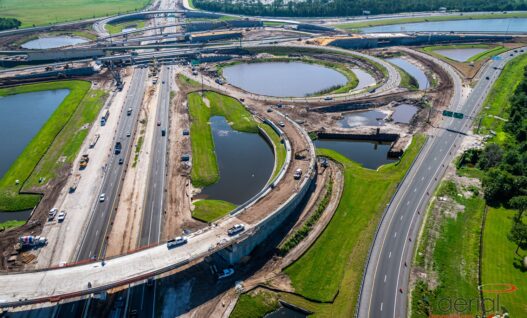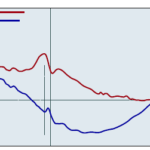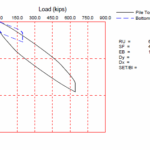Central Florida Expressway SR 528 and SR 436 Interchange Reconfiguration
Project:
Florida’s Beachline State Road (SR) 528 was the first road on the Central Florida Expressway (CFX), built in 1967 at a cost of $7 million. It connects Central Florida and the Orlando International Airport to the Cape Canaveral Space Force Station, Kennedy Space Center, and the beaches along the east coast, making it vital to residents and visitors alike. In the summer of 2020, the CFX broke ground on a reconfiguration of the SR 528 and SR 436 interchange. The goal was to transform the various existing loop ramps into semi-directional flyovers, providing a smoother, more efficient transition for the heavy airport traffic flow. Due to its important location, the construction would need to be completed quickly, without sacrificing access and convenience to the traveling public. The project’s seven bridges were founded on steel H-piles. GRL Engineer’s role was to assist with the geotechnical and pile driving aspects for fast and efficient construction. GRL Engineers assisted with the review of the Pile Installation Plan (PIP) for pre-construction assessment of pile drivability by wave equation analyses using the GRLWEAP computer program. During construction, GRL Engineers provided Pile Driving Analyzer® (PDA) pile testing, CAPWAP analyses of the Test Piles and some production piles, issued recommendations for production piles lengths and driving criteria, and reviewed the production piles driving logs.
Method and Results:
The deep foundations for the twenty pile bents supporting the seven bridges were HP 14×89 steel H-piles that ranged in length from about 130 to 200 feet and Nominal Bearing Resistances from about 400 to 500 kips. Open-ended diesel hammers were used to drive the piles; originally a D-30 size hammer was tried, which was changed to a larger D-46 hammer to expedite pile driving. All Test Piles were monitored with a PDA during initial driving and some also during restrike. A few production piles were also tested with the PDA as part of quality control verification testing. Based on PDA testing and CAPWAP analyses results, GRLWEAP wave equation analyses were performed utilizing bridge/bent specific data to issue production piles installation criteria.
As an example of GRL recommendations a production pile length of 150 feet was proposed to achieve a 450-kip Nominal Bearing Resistance. The corresponding driving criteria utilizing the D-46 hammer was 54 blows/foot with a minimum hammer stroke eight of 7.7 feet for two feet of pile penetration. If the blow count criteria is not reached stop pile driving one foot above cutoff elevation and notify the Engineer for recommendations and direction. Since all piles will require field splicing sections, the bottom section may be installed with a vibro-hammer; while the remaining section(s) must be driven with the diesel impact hammer. Pile driving with the diesel hammer shall start with hammer fuel setting #1 (i.e., lowest setting), the fuel setting may be increased to the next higher setting when the blow count exceeds 45 blows/foot, until the terminating driving criteria is met.
PDA dynamic pile testing was performed on a few production piles for cases where the driving criteria was not met at the end of driving, following hammer repairs, unusual driving characteristics, or as a part of routine quality control.
The successful and exemplary deep foundations installations work on this project was made possible by using steel piles and effective utilization of PDA/CAPWAP/GRLWEAP testing and analysis services. At each of the pile bent locations, driving and testing of the Test Pile was done in a few hours (including welding of the various sections), data analysis and recommendations for the location’s production piles length and driving criteria were typically issued on the following day. Immediately following the driving of the Test Pile, the contractor started installing the bottom sections of the production piles, without any down time or delays. By the time the bottom pile sections of the production piles are installed, the length and driving criteria recommendations are issued and the work proceeded seamlessly, fast and efficiently.
The interchange reconfiguration cost an estimated $118 Million and was completed eight months ahead of schedule. The traffic flow around the north entrance of the Orlando International Airport has been reported as smoother and safer. The project received the Florida Transportation Builders Association (FTBA) “Florida’s Best in Construction Expressway Authority 2022” award to recognize outstanding quality construction. GRL Engineers are honored with this recognition as part of the project team. The project also received the Honor Award for the 2023 ACEC-FL Excellence in Engineering.
Project Details
Client: RK&K / CFX
GRL Office: Florida
GRL Services
- GRLWEAP Pile Driveability Analysis
- High Strain Dynamic Testing
- CAPWAP® Analyses
- Production Piles Length and Driving Criteria
- Review of Pile Driving Logs
- Figure 1. Typical End of Driving PDA Test Record
- Figure 2. Typical CAPWAP Generated Pile Top and Bottom Static Load vs Displacement Plots






